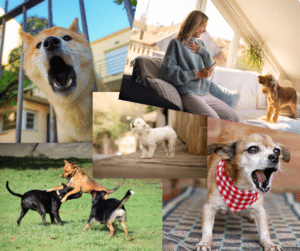Why Is My Dog Barking So Much: The Ultimate Guide to Calmer Canines
Understanding Why Dogs Bark
Dogs bark—it’s their way of communicating. While barking is entirely natural, it can quickly become a problem when it’s excessive. If you’re living with a dog whose barking seems endless, it’s easy to feel frustrated, and you’re not alone. Barking that disrupts your household or annoys the neighbours is one of the most common challenges dog owners face.
But here’s the thing: barking is your dog’s language. They’re not doing it to wind you up; they’re trying to tell you something. Maybe they’re scared, bored, or simply excited. Whatever the reason, it’s their way of expressing what they’re feeling. Think of barking as a tool they use to navigate the world and interact with you.
In places like Hamilton, where houses are close together and life is bustling, barking can feel like an even bigger challenge. The constant noise and activity outside can easily trigger your dog. The good news is that excessive barking is something you can address—with patience, understanding, and the right approach.
Types of Dog Barking and What They Mean
If you’re wondering why your dog barks so much, the first step is understanding the different types of barking. Each kind of barking has a purpose. It’s not all the same, and when you learn to identify the type of barking, you can start figuring out how to manage it.
Attention-Seeking Barking
Imagine this: you’re sitting on the sofa, finally taking a moment for yourself, and your dog starts barking. This is classic attention-seeking behaviour. They want your focus, whether it’s for food, play, or affection. Dogs are clever; they quickly learn that barking grabs your attention, and that’s exactly what they’re after.

Alert or Spook Barking
Alert barking often comes out of nowhere. It happens when your dog notices something unfamiliar, like a strange sound or movement. They’re telling you, “Hey, there’s something happening—pay attention!” It’s a protective instinct, but in a busy place like Hamilton, where there’s always a car horn or a passer-by, this type of barking can feel constant.
Territorial Barking
Territorial barking takes alert barking a step further. This happens when your dog feels their space is being invaded. They might bark furiously at someone walking past the garden or at a delivery driver coming to the door. It’s their way of saying, “This is my space—stay away!”
Resource-Guarding Barking
If your dog barks when someone approaches their food bowl, toys, or even you, they’re showing resource-guarding behaviour. This type of barking comes from a deep-seated instinct to protect valuable resources.
Boredom or Loneliness Barking
When dogs are left alone for long periods or don’t get enough stimulation, they bark out of sheer boredom or loneliness. Imagine being stuck in a room all day with nothing to do. Barking becomes a way for them to pass the time or express their frustration.
Separation Anxiety Barking
This type of barking is more emotional. It’s not about boredom; it’s about genuine distress. If your dog barks as soon as you leave the house, paces around, or shows other signs of anxiety, they might be struggling with separation anxiety.
Excitement Barking
Excitement barking is usually loud and happy. It happens when your dog is anticipating something fun, like going for a walk or seeing a favourite person. While it’s positive, it can still get out of hand if it’s not managed.
Compulsive Barking
Compulsive barking is more serious. This repetitive behaviour often happens without an obvious reason and can be a sign of stress or even a health issue. If your dog barks compulsively, it’s worth consulting a vet or behaviourist.
Did I Cause My Dog’s Barking?

As a dog owner, it’s natural to question whether you’ve contributed to your dog’s barking. The truth is, dogs are highly responsive to their environment, including how you interact with them. In some cases, your actions—often unintentionally—may reinforce the behaviour.
One common scenario is rewarding barking without realising it. Let’s say your dog barks to get your attention, and you respond by talking to them or giving them a treat to quieten them down. To your dog, this means barking works—they got what they wanted. Over time, they learn that barking is an effective way to get your attention or a reward.
Another way you might unintentionally encourage barking is by reacting emotionally. For instance, if your dog barks at the doorbell and you shout at them to stop, they might interpret your shouting as you joining in the excitement. Or as soon as someone enters that door, they have a party with your dog and they learn that the doorbell also could mean fun is about to happen. Instead of discouraging the behaviour, it can escalate it.
Even neglecting training or socialisation can play a role. If your dog hasn’t been exposed to various situations, people, or sounds during their formative months, they may become overly reactive to new experiences. This lack of socialisation can lead to fear-based barking later in life.
Living in a busy area like Hamilton can also increase the likelihood of unintentional reinforcement. With so many potential triggers, it’s easy for patterns to form without you noticing. The good news is that these patterns can be changed with consistent training and a bit of patience.
By reflecting on how you respond to your dog’s barking, you can start to shift your approach. Positive reinforcement, structured routines, and consistent boundaries go a long way in reshaping their behaviour and breaking the cycle of excessive barking.
Identifying the Cause of Your Dog’s Barking
Once you’ve identified the type of barking, the next step is to figure out what’s triggering it. This requires a bit of detective work, but it’s absolutely essential for addressing the behaviour.
Start by observing your dog. When does the barking happen? Is it always at the same time of day, or is it triggered by something specific, like the sound of the doorbell or seeing another dog? Keep a diary for a week to track the patterns. Write down when and where the barking happens and what’s going on around your dog.
If you live in Hamilton, your environment could be playing a big role. The constant activity outside—like cars, pedestrians, and other dogs—can be overwhelming for some dogs. Identifying whether these external factors are triggers is key to managing the behaviour.
It’s also important to consider your dog’s emotional state. Are they barking out of fear or frustration? Are they overly excited or just plain bored? Understanding their feelings will help you address the root cause of the barking rather than just the symptom.
Finally, don’t overlook health. If your dog’s barking is new or has suddenly increased, it could indicate an underlying medical issue, such as pain or cognitive decline. A visit to the vet can rule out any physical causes and give you peace of mind.
How to Effectively Manage Barking
Managing barking starts with meeting your dog’s basic needs. A dog that’s tired from plenty of exercise and mentally stimulated with activities is less likely to bark excessively. Make sure your dog gets enough daily walks and has opportunities for play and mental challenges, like puzzle toys.
One of the biggest mistakes people make is reacting to barking with shouting or scolding. To your dog, even negative attention is still attention, and it reinforces the behaviour. Instead, try to ignore unwanted barking and reward the quiet moments.
If you’re feeling stuck, reaching out to a professional can make all the difference. K9 Principles, a highly trusted name in Hamilton dog training, offers tailored support to address barking issues. Our expertise can help you implement effective strategies that work for both you and your dog.
Positive Reinforcement Strategies
Positive reinforcement is one of the most effective ways to manage barking. The idea is simple: reward the behaviours you want to see more of and ignore the ones you don’t.
For instance, if your dog tends to bark at the doorbell, you can teach them to go to their bed instead. Every time they stay calm and quiet, reward them with a treat or praise. Over time, they’ll learn that the doorbell means going to their bed—not barking at the door.

You can also teach a cue like “Quiet.” Wait for a moment of silence, say the word “Quiet,” and immediately give your dog a reward. Be consistent, and your dog will soon understand what you’re asking of them.
Environmental Management Tips
Sometimes, the easiest way to manage barking is to control your dog’s environment. If your dog barks at people walking past the window, block their view with curtains or frosted glass. For dogs who are triggered by noises, a white noise machine can help mask the sounds of traffic or other dogs barking outside.
Creating a quiet, safe space for your dog can also help. This could be a cozy area in your home where they can retreat when they feel overwhelmed. Add a comfortable bed, their favourite blanket, and some toys to make it inviting.
The Role of Professional Help in Barking Issues
If you’ve tried everything and your dog’s barking still feels unmanageable, don’t hesitate to seek professional help. K9 Principles, a leading provider of dog training in Hamilton, specialises in addressing behavioural challenges like excessive barking. Our in-home private dog training is the perfect choice for issues you may be facing such as barking.
Our approach is tailored to your dog’s specific needs, whether they’re struggling with fear-based barking, separation anxiety, or overexcitement. By working with one of our professional dog trainers in the comfort of your own home, you’ll gain valuable insights into your dog’s behaviour and learn practical strategies to address the issue.
Professional dog training isn’t just about solving problems; it’s about building a stronger bond with your dog. With the right guidance, you can create a more peaceful and harmonious relationship.
Conclusion: Building a Peaceful Bond with Your Dog
Excessive barking can feel overwhelming, but it’s important to remember that your dog isn’t barking to be difficult—they’re trying to communicate. By understanding the reasons behind their barking and addressing the root cause, you can create a quieter, happier home for both of you.
Whether it’s through positive reinforcement, environmental management, or expert help from K9 Principles, tackling barking is entirely achievable. With time, patience, and consistency, you’ll not only reduce the barking but also strengthen your bond with your dog.
- Name: K9 Principles
- Address: Haldimand County, Greater Hamilton Area, Burlington, and Most of Norfolk County
- Phone: 289 880-3382
- Email: k9principlesinc@gmail.com
- Website: www.k9principles.ca
FAQs
-
A. Teaching your dog to associate the doorbell with a positive action, like going to their bed, can help. Reward them for staying calm to reinforce the behaviour.






